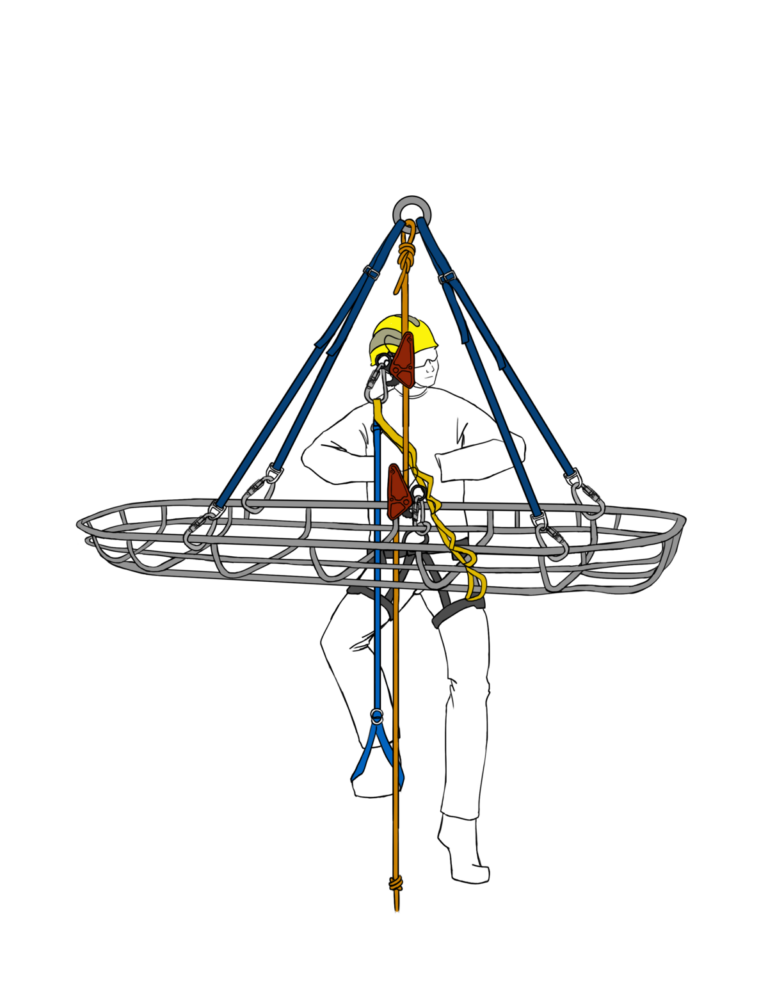Earlier this week, I was asked to provide a quick list of talking points for a group of technicians who regularly gather for their own MasterMind group. Obviously, I was happy to oblige. I suggested breaking the question into two parts:
- Rope Rescue Gear/Equipment Topics
- Rope Rescue Field Problem Topics
Rope Rescue Gear/Equipment Topics
Advanced rope rescue operations rely on specialized equipment to ensure safety, efficiency, and adaptability to a wide range of scenarios. Below is a comprehensive list of essential gear categories, their purposes, and considerations:
Ropes and Webbing
- Static Kernmantle Rope: With minimal stretch, these ropes provide stability in anchor and hauling systems, essential for controlled operations.
- Dynamic Rope: Designed to absorb the energy of falls, they are used in dynamic rescue scenarios or lead climbing setups.
- Webbing and Slings: Versatile tools for constructing anchors, extending protection points, and improvising systems.
Harnesses
- Full-Body Harnesses: Distribute impact forces evenly, ensuring comfort and safety for rescuers.
- Chest Harnesses: Help maintain orientation, preventing inversion during access or rescue operations.
Hardware
- Carabiners: Integral for connecting ropes, slings, and systems; available in locking and non-locking variations.
- Pulleys: Reduce friction and enable mechanical advantage systems for lifting and hauling.
- Ascenders and Descenders:
- Ascenders: Aid in climbing ropes efficiently.
- Descenders (e.g., Figure-8 devices): Provide controlled descent with customizable friction.
Anchors and Anchor Systems
- Static Anchors: Rigid fixed points for attaching systems.
- Dynamic Anchors: Adjustable points accommodating shifts in load or angle.
- Multi-Point Anchor Systems: Provide redundancy, increasing system safety and distributing forces.
Rigging Plates and Multipliers
- Rigging Plates: Organize and manage multiple connections, ideal for complex setups.
- Mechanical Advantage Systems: Enable the use of less force for heavier loads, such as 3:1 or 5:1 pulley setups.
Rope Grabs and Prusiks
- Rope Grabs: Offer adjustable progress capture for controlled movement along ropes.
- Prusik Knots: Friction knots that provide grip and control, often used as backups or in tandem with mechanical devices.
Rescue Belay Devices
- Load-Release Belay Devices: Precision tools that allow controlled release of a load under tension, ideal in rescues.
Helmets and Protective Gear
- Helmets: Protect against impact and falling debris; mandatory in all operations.
- Gloves: Offer protection and improve handling during rope operations.
Personal Protective Equipment (PPE)
- Fall Arrest Lanyards and Devices: Critical for preventing falls or minimizing impact forces during unforeseen events.
Patient Care
Specialized gear like backboards, immobilization harnesses, and litters ensure safe and effective transport of patients during rescues.
Communication and Lighting
- Two-Way Radios: Crucial for seamless coordination during complex, multi-stage rescues.
- Headlamps: Provide hands-free illumination in confined or low-light scenarios.
Rope Rescue Field Problem Topics
Field scenarios often introduce dynamic challenges requiring improvisation, teamwork, and innovative problem-solving. Below are some focus areas for field discussions:
Systems & Kits
- Pre-Configured Kits: Discuss advantages and limitations of pre-assembled kits versus modular setups.
- System Analysis: Understanding load distributions, angles, and forces in real-time operations.
Training Programs
- Scenario-Based Training: Emphasize hands-on drills simulating real-world challenges.
- Advanced Rigging Workshops: Delve into niche topics such as highlines, floating anchors, and mechanical advantage systems.
- Certifications: Explore available certifications and how they align with industry standards.
Problem-Solving Topics
- Unanticipated Anchor Points: Strategies for creating anchors in environments lacking ideal options.
- Force Management: Techniques for managing forces on marginal anchors or in heavy-load scenarios.
- Edge Transition Challenges: Innovations to mitigate abrasion and friction at sharp edges.
Additional Talking Points
- Rescue Technology Integration: Explore how new tools, like drones or advanced software, are changing field operations.
- Team Dynamics and Communication: Emphasize soft skills essential for field efficiency and safety.
- Field Innovations: Share and discuss unique solutions encountered during operations.
By structuring discussions around these talking points, technicians in the MasterMind group can deepen their understanding of both equipment capabilities and field applications, fostering a collaborative learning environment.










